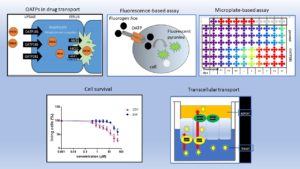Introduction
Organic anion transporting polypeptides (OATPs) are Solute Carrier (SLC)-type polypeptides expressed in the cell membrane of epithelial or endothelial cells of the human body. OATPs mediate the cellular uptake of large, usually amphipatic or negatively charged organic molecules, including bilirubin, bile acids and steroid or thyroid hormones. Hence, OATPs are important in bile acid and hormone homeostasis. On the other hand, several members of the OATP family also transport various medicines and influence the absorption, distribution and elimination (ADME) of their drug substrates. The two major drug transporter OATPs with renowned role in pharmacokinetics are OATP1B1 and OATP1B3 expressed in hepatocytes. According to the recommendations by international regulatory agencies (FDA, EMA and PMDA) interaction between these OATPs and new molecular entities is recommended during drug development. On the other hand, other members of the OATP family overexpressed in tumors or important in the thyroid transport of the central nervous system (OATP1C1) are also potential pharmacological targets.
Major projects
Development of fluorescence-based methods for studying drug-transporter interactions
Radiolabeled indicators are most widely used to measure drug interactions of OATPs. However, lately fluorescent probes are also gaining wider application in OATP tests. Recently, we have developed various fluorescence-based methods for studying renowned drug transporter or less-well characterized OATPs1-6. One of the major focuses of our research is the further development and refining of these fluorescence-based methods.

The role of OATPs in cancer progression and therapy response
Although increased or ectopic expression of OATPs was documented in various tumors its relevance has not yet been clarified. One of our projects is the investigation of the role of OATPs in tumor progression and, also in chemotherapy response.
Interaction between exogenous or endogenous compounds with multispecific OATPs
In the frame of collaborations, we have identified various natural and artificial inhibitors of OATPs7-9. These studies are still going on in order to find specific and high affinity OATP inhibitors as well as to reveal cellular toxicities caused by OATP function.
Recent publications:
- Patik I, Kovacsics D, Német O, Gera M, Várady G, Stieger B, Hagenbuch B, Szakács G, Özvegy-Laczka C. Functional expression of the 11 human Organic Anion Transporting Polypeptides in insect cells reveals that sodium fluorescein is a general OATP substrate. Biochem Pharmacol. 2015 Dec 15;98(4):649-58.
- Patik I, Székely V, Német O, Szepesi Á, Kucsma N, Várady G, Szakács G, Bakos É, Özvegy-Laczka C. Identification of novel cell-impermeant fluorescent substrates for testing the function and drug interaction of Organic Anion-Transporting Polypeptides, OATP1B1/1B3 and 2B1. Sci Rep. 2018 8:2630
- Bakos E, Tusnády GE, Német O, Patik I, Magyar Cs, Németh K, Kele P, Özvegy-Laczka C. Synergistic transport of a fluorescent coumarin probe marks coumarins as pharmacological modulators of Organic anion-transporting polypeptide, OATP3A1. Biochemical Pharmacology, 2020 Dec;182:114250.
- Bakos É, Német O, Patik I, Kucsma N, Várady G, Szakács G, Özvegy-Laczka C. A novel fluorescence-based functional assay for human OATP1A2 and OATP1C1 identifies interaction between third-generation P-gp inhibitors and OATP1A2. FEBS J. 2020 Jun;287(12):2468-2485.
- Székely V, Patik I, Ungvári O, Telbisz Á, Szakács G, Bakos É, Özvegy-Laczka C. Fluorescent probes for the dual investigation of MRP2 and OATP1B1 function and drug interactions. Eur J Pharm Sci. 2020 Aug 1;151:105395.
- Ungvári O, Király L, Bakos É, Özvegy-Laczka C. 8-acetoxy-trisulfopyrene as the first activatable fluorogenic probe for add-and-read assessment of Organic anion-transporting polypeptides, OATP1B1, OATP1B3, and OATP2B1. FASEB J. 2021 Sep;35(9):e21863.
- Laczkó-Rigó R, Bakos É, Jójárt R, Tömböly C, Mernyák E, Özvegy-Laczka C. Selective antiproliferative effect of C-2 halogenated 13α-estrones on cells expressing Organic anion-transporting polypeptide 2B1 (OATP2B1). Toxicol Appl Pharmacol. 2021 Aug 30;429
- Jójárt R, Laczkó-Rigó R, Klement M, Kőhl G, Kecskeméti G, Özvegy-Laczka C, Mernyák E. Design, synthesis and biological evaluation of novel estrone phosphonates as high affinity organic anion-transporting polypeptide 2B1 (OATP2B1) inhibitors. Bioorg Chem. 2021 Jul;112:104914
- Mohos V, Fliszár-Nyúl E, Ungvári O, Bakos É, Kuffa K, Bencsik T, Zsidó BZ, Hetényi C, Telbisz Á, Özvegy-Laczka C, Poór M. Effects of chrysin and its major conjugated metabolites chrysin-7-sulfate and chrysin-7-glucuronide on cytochrome P450 enzymes, and on OATP, P-gp, BCRP and MRP2 transporters. Drug Metab Dispos. 2020 Oct;48(10):1064-1073
Collaborations
Szerves Kémiai intézet, TTK
Szegedi Tudományegyetem
Pécsi Tudományegyetem
Zürichi Egyetem
Bécsi Egyetem

